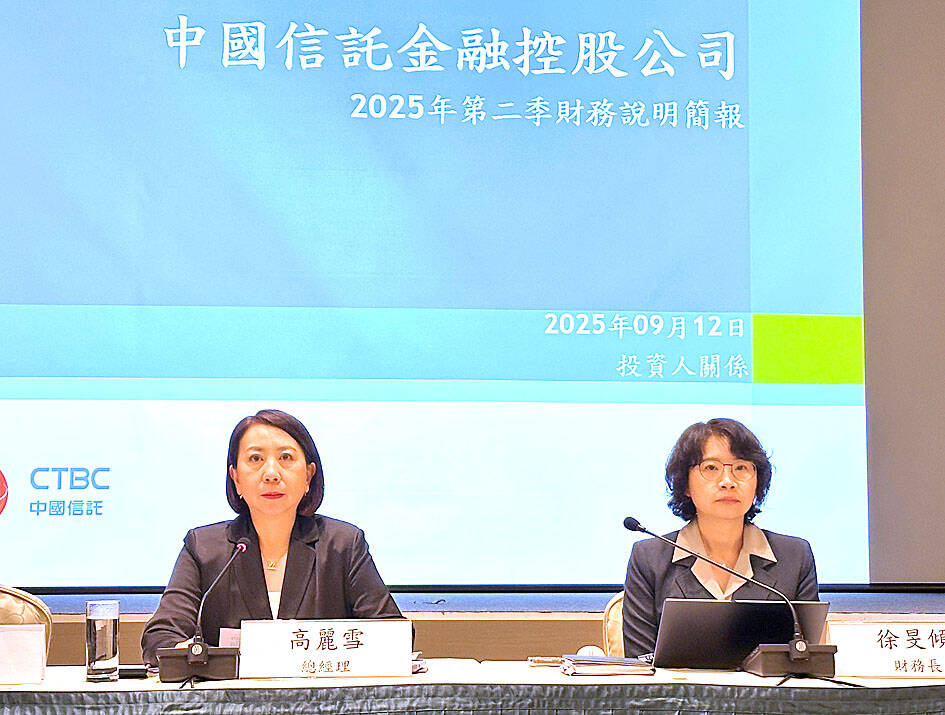CTBC Financial Holding Co (中信金), Taiwan’s third-largest financial group by assets, yesterday said it would maintain its strategy of keeping a 70-30 split between banking and non-banking operations as it pursues growth and acquisition opportunities.
The group shared its development plans after reporting that first-half net income was NT$35.84 billion (US$1.18 billion), down 4 percent year-on-year, but outperforming the sector’s 35 percent slump.
Its flagship unit, CTBC Bank (中國信託銀行), delivered record earnings, while life insurance arm, Taiwan Life Insurance Co (台灣人壽), reported a 45 percent drop, weighed down by foreign-exchange losses.

Photo: CNA
CTBC Financial president and spokeswoman Rachael Kao (高麗雪) expressed cautious views for the second half, highlighting global trade tensions, tariff risks and equity market volatility as potential headwinds.
Taiwan’s economy expanded 6.75 percent in the first half, but expansion is expected to slow to 2.3 percent in the remainder of the year, as many companies had front-loaded orders in anticipation of US tariff measures, Kao said.
CTBC Bank posted after-tax profit of NT$27.7 billion in the year to June, a 20 percent rise from the first half last year, fueled by 13 percent loan growth and nearly 20 percent growth in net interest income due to lower foreign-currency funding costs.
Fee income rose by a nearly double-digit percentage, supported by wealth management initiatives.
Overseas operations contributed NT$12.4 billion in pretax profit, up 10 percent from a year earlier and accounting for 36 percent of the total, among the highest in Taiwan’s financial industry.
By contrast, Taiwan Life booked NT$7.2 billion in profit, down 45 percent, as the New Taiwan dollar’s appreciation against the US dollar resulted in foreign-exchange losses.
The insurer boosted its capital base by adding NT$15.1 billion to reserves in June under a new regulatory reserve regime.
First-year premium sales climbed by about NT$1.7 billion in the year through July, helped by expanded distribution channels and diversified product offerings.
Kao declined to comment on media speculation regarding a potential acquisition of Mercuries Life Insurance Co (三商美邦人壽), reiterating that CTBC Financial Holding would adhere to its 70-30 principle guiding banking and non-banking operations.
The group would favor acquisitions that can generate asset synergies, improve profitability and capital allocation, and enhance customer services, she said.
Taiwan Life is expected to maintain a 125 percent solvency ratio under the new accounting rules next year, company officials said.
While the US Federal Reserve is tilting toward rate cuts, Kao said that trade uncertainties and market swings require careful management to safeguard investments.

With this year’s Semicon Taiwan trade show set to kick off on Wednesday, market attention has turned to the mass production of advanced packaging technologies and capacity expansion in Taiwan and the US. With traditional scaling reaching physical limits, heterogeneous integration and packaging technologies have emerged as key solutions. Surging demand for artificial intelligence (AI), high-performance computing (HPC) and high-bandwidth memory (HBM) chips has put technologies such as chip-on-wafer-on-substrate (CoWoS), integrated fan-out (InFO), system on integrated chips (SoIC), 3D IC and fan-out panel-level packaging (FOPLP) at the center of semiconductor innovation, making them a major focus at this year’s trade show, according

DEBUT: The trade show is to feature 17 national pavilions, a new high for the event, including from Canada, Costa Rica, Lithuania, Sweden and Vietnam for the first time The Semicon Taiwan trade show, which opens on Wednesday, is expected to see a new high in the number of exhibitors and visitors from around the world, said its organizer, SEMI, which has described the annual event as the “Olympics of the semiconductor industry.” SEMI, which represents companies in the electronics manufacturing and design supply chain, and touts the annual exhibition as the most influential semiconductor trade show in the world, said more than 1,200 enterprises from 56 countries are to showcase their innovations across more than 4,100 booths, and that the event could attract 100,000 visitors. This year’s event features 17

EXPORT GROWTH: The AI boom has shortened chip cycles to just one year, putting pressure on chipmakers to accelerate development and expand packaging capacity Developing a localized supply chain for advanced packaging equipment is critical for keeping pace with customers’ increasingly shrinking time-to-market cycles for new artificial intelligence (AI) chips, Taiwan Semiconductor Manufacturing Co (TSMC, 台積電) said yesterday. Spurred on by the AI revolution, customers are accelerating product upgrades to nearly every year, compared with the two to three-year development cadence in the past, TSMC vice president of advanced packaging technology and service Jun He (何軍) said at a 3D IC Global Summit organized by SEMI in Taipei. These shortened cycles put heavy pressure on chipmakers, as the entire process — from chip design to mass

SEMICONDUCTOR SERVICES: A company executive said that Taiwanese firms must think about how to participate in global supply chains and lift their competitiveness Taiwan Semiconductor Manufacturing Co (TSMC, 台積電) yesterday said it expects to launch its first multifunctional service center in Pingtung County in the middle of 2027, in a bid to foster a resilient high-tech facility construction ecosystem. TSMC broached the idea of creating a center two or three years ago when it started building new manufacturing capacity in the US and Japan, the company said. The center, dubbed an “ecosystem park,” would assist local manufacturing facility construction partners to upgrade their capabilities and secure more deals from other global chipmakers such as Intel Corp, Micron Technology Inc and Infineon Technologies AG, TSMC said. It